Biosecurity is the management of the risk of pests and diseases entering, emerging, establishing or spreading in Australia and causing harm to animals, plants or human health, the economy, the environment and the community.
New ABARES report provides an overview of current biofouling practices across the nation

Boat with biofouling on hull.
ABARES recently released the Recreational boat operators’ self-management of biofouling in Australia report, providing an overview of current biofouling practices by boat operators across the nation and movements of recreational vessels around Australia's coastline.
A survey involving more than 1,585 recreational boaters who have a high level of awareness of marine pest risks fed into this report. 883 of the survey respondents owned vessels, such as yachts and motor cruisers that remain in the water most of the time. Stationary vessels are particularly susceptible to invasive marine plants and animals.
Many thanks to all the recreational boat operators who participated in the study and to all the stakeholders who assisted us in promoting the national recreational boater survey.
Continue reading about new ABARES report provides an overview of current biofouling practices across the nation
Domestic recreational boat operators who participated in the survey already undertake a range of biofouling management actions on a regular basis. More than 60 per cent were using best-practice approaches, such as regularly cleaning the boat hull and niche areas of the boat, renewing anti-fouling coatings each year and capturing biofouling waste after cleaning. Close to 70 per cent also said they would be likely to capture and dispose of biofouling waste in the future.
The survey did find only a small contingent were cleaning their boats before moving to another location, which is the most effective action in reducing vessel biofouling that domestic boaters can take. However, the majority of respondents were interested in engaging in more biofouling practices and had considerable interest in doing the right thing to protect the environment.
Biofouling is a term for the growth on a boat’s hull that can move invasive plants and animals from one marine environment to another, which poses a serious threat to native biodiversity and can have widespread effects on the economy and ecosystem health.
Australia’s national approach to domestic marine pest biosecurity relies on voluntary uptake of the national biofouling management guidelines by recreational vessel operators, to prevent and manage biofouling growth.
The report was published on the ABARES publications site.
Keeping African swine fever out of Australia
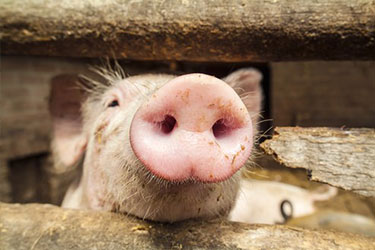
African swine fever is a real threat, but you can help save our bacon.
African swine fever is a highly contagious viral disease of domestic and wild pigs, and it’s on the move with recent outbreaks occurring in Western Europe and China.
Dr Mark Schipp, Australia’s Chief Veterinary Officer, said African swine fever has been present in sub-Saharan Africa countries for some time but recent outbreaks in Belgium and China are cause for concern.
Dr Schipp has warned that this disease would have serious consequences if people fail to comply with Australia’s biosecurity requirements and it makes its way to Australia.
‘If you are travelling or returning to Australia from overseas, or purchasing goods online, you have a role in keeping this disease out. It’s not just the responsibility of biosecurity authorities and our pig industry.’
Continue reading about keeping African swine fever out of Australia
This disease can survive on the surface of an item or within a food product for an extended period of time, which means that items like footwear, clothing and equipment, as well as contaminated food can spread the disease.
Before you pack to travel to Australia make sure your gear is thoroughly clean, especially if you’ve used it around animals or in a rural area. This also applies to items like camping or hunting equipment.
‘The simple message is make sure your things are clean, and free of soil and other organic materials before you pack your bags. And don’t bring food with you, particularly meat and meat products,’ Dr Schipp said.
Exotic diseases are not something that may be front of mind when shopping online, however, you do need to consider where your items are coming from and whether they will meet our biosecurity requirements when they arrive at Australia’s international mail facility.
‘Now is a good time to also remind friends and family overseas of what they can and can’t mail to Australia, or what they should leave at home if they’re coming to visit.’
You can check what can and cannot come into Australia on the department’s website.
Pig owners also have a critical role in keeping African swine fever out of Australia. You need to protect your pigs from disease, regardless of whether you are a large-scale producer or you keep a pet pig in your backyard.
Dr Schipp said providing pigs with good and safe food plays an important part in keeping them healthy and are part of pig producers’ responsibilities.
‘Pigs must not be fed meat, food containing meat or food which has been in contact with meat. Also, you must not feed your pigs imported dairy products.’
This practice is known as swill feeding, and it is prohibited in all Australian states and territories. It has the potential to introduce serious diseases like African swine fever or foot-and-mouth disease into our livestock.
Swill feeding is believed to have contributed to the recent international spread of African swine fever.
Australia has science-based import conditions in place to manage the risk associated with imported goods. To manage the risk associated with African swine fever, imported pig meat must either be canned or cured under very specific conditions to inactivate the virus, or sourced from countries or zones that are free of the disease.
Dr Schipp said that the department is keeping a close watch on the African swine fever situation overseas.
‘The department is collaborating closely with industry, with a priority focus on keeping Australia’s pig herd free of this devastating disease.’
For more information see our web page on African swine fever.
Awards to recognise biosecurity heroes now open

(L-R) Secretary, Daryl Quinlivan, 2018 joint industry awards winners Cahill Transport Australia, Panalpina World Transport Pty Ltd and Husqvarna Australia Pty Ltd, and Deputy Secretary, Lyn O’Connell.
You can now nominate individuals and businesses who have made outstanding contributions to the protection of our $60 billion-a-year agricultural industries and the health of our animals, plants and people.
The 2019 Australian Biosecurity Awards recognise individuals and groups that show a commitment to working with the Department of Agriculture and Water Resources to support and promote Australia's biosecurity and the systems that uphold it.
There are four award categories: the David Banks Biosecurity Lifetime Achievement; Industry; Government; and Farm Biosecurity Producer of the Year.
Peta Lane, head of the department’s Compliance division, said ‘Our biosecurity system protects our unique environment, agricultural production and our quality of life – but it also relies on each of us to play our part.’
‘If you know someone who has made a significant contribution to our biosecurity system, we’d like you to nominate them for an Australian Biosecurity Award.’
The 2019 Australian Biosecurity Awards will be presented in conjunction with the Science and Innovation Awards for Young People in Agriculture, Fisheries and Forestry as part of the ABARES Outlook Conference in Canberra in March 2019.
Nominations are open until Friday 9 November 2018.
Find out more about the Australian Biosecurity Awards.
Bee prepared workshop to test Australia's Varroa defence
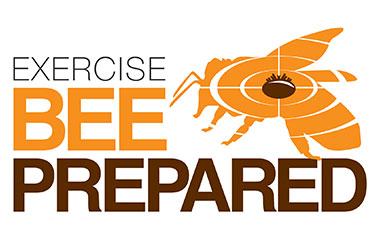
Government and industry are taking part in one of the nation’s largest biosecurity exercises to be prepared for a Varroa mite incursion.
If the vexatious Varroa mite ever made its way to Australia it could be devastating for our honey bees, and the industries that rely on them.
Government and industry stakeholders from across the country are taking part in one of the nation’s largest biosecurity exercises to help Australia be prepared to manage a potential Varroa mite incursion.
Dr Kim Ritman, Australian Chief Plant Protection Officer, said as part of Exercise Bee Prepared, workshops were being held in a number of jurisdictions to test Australia’s response to an incursion.
‘Varroa mite is a significant honey bee parasite in other countries around the world. It causes colonies to decline as well as transmitting viruses in bees and is one of our most unwanted biosecurity pests,’ Dr Ritman said.
Continue reading about bee prepared workshop to test Australia's Varroa defence
‘Australia has over 20,000 beekeepers and the honey industry is valued at over $90 million a year. The pollination services bees provide are estimated to be worth $4-6 billion per year.’
‘We are the only continent free of Varroa destructor. To provide assurance that the measures we have in place would allow us to effectively respond to and manage a Varroa incursion, it is important that we put them to the test.’
‘Through the Exercise Bee Prepared workshops, tailored scenarios are being run in each state and territory to help demonstrate our preparedness to detect, contain and manage an incursion.’
To date, over 160 government and honeybee industry representatives have been through the workshops, which have highlighted areas where we are doing well and where potential improvements can be made.
‘It has been a great opportunity to share information and learn from jurisdictions and experts from the honeybee industry, to ensure Australia has the best possible chance to manage a Varroa incursion.’ Dr Ritman said.
The workshops are being delivered by Plant Health Australia and funded by the Department of Agriculture and Water Resources. They are being run in the ACT, New South Wales, Northern Territory, Queensland, South Australia, Tasmania, Victoria and Western Australia.
There are a range of biosecurity requirements, surveillance and response arrangements in place to manage the risk of Varroa mite arriving and establishing in Australia.
This includes the National Bee Pest Surveillance Program, which provides early warning for bee pests and pest bees at ports around Australia.
For more information on the Exercise Bee Prepared.
Creating invasive species solutions
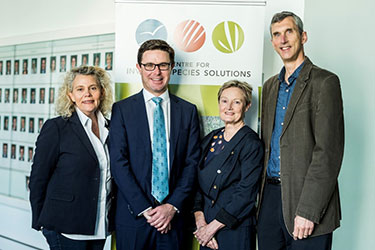
L-R: Fiona Simson (President National Farmers Federation), David Littleproud (Federal Minister for Agriculture and Water Resources), Helen Cathles (Chair, Centre for Invasive Species Solutions) and Andrew Cox (CEO, Invasive Species Council).
Australian farmers will have more 'ammo' in the fight against pest animals thanks to a suite of projects launched by the Centre for Invasive Species Solutions (CISS).
The CISS has established a strong member and partner collaborative research, development and extension (RD&E) platform that has initially brought together state and territory government agencies, the Department of Agriculture and Water Resources, industry RDCs (namely Meat and Livestock Australian and Australian Wool Innovation), CSIRO and universities to focus on the development of improved tools and strategies that will strengthen vertebrate pest management.
The 21 new RD&E projects have been co-developed with members and partners. They are focused on developing solutions to continue to manage problematic species such as rabbits, wild dogs and deer, with a significant investment in developing new detection and surveillance techniques of potential threats.
The innovative set of projects was officially launched by David Littleproud in September at Parliament House.
Continue reading about creating invasive species solutions
‘Farmers face huge costs, productivity losses and the spread of diseases at the hands of pests and weeds and keep fighting to stop them in their tracks,’ Minister Littleproud said.
‘The 21 projects target pest animals in particular and will look at new management tools, better strategic decision making as well as community engagement and education.’
‘One project, worth $1.84 million, will look at building a machine to test samples of water to identify traces of pest animal DNA in rapid time out in the field. This technology would help track down pests hiding below the surface like the Asian black-spined toad and red-eared slider turtle.’
‘Another two projects worth a combined $4.2 million will look at how to cost-effectively manage deer by looking at their behaviour and determine their role in the transmission of diseases to livestock. Deer are an emerging threat in Australia and we need to understand their role in spreading diseases such as foot-and-mouth disease.’
‘The Australian Government is contributing $20 million over five years towards CISS ‘
‘CISS is developing a 10-year weeds RD&E investment plan to identify the priority areas in our war against weeds,’ Minister Littleproud said.
Find out more about CISS and its first RD&E portfolio.
Valuable experience by helping the neighbours
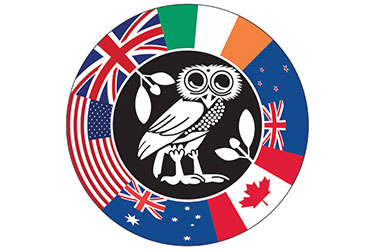
The IAHER and its supporting operations manual was tested in Exercise Athena in 2016.
Australia is lucky to have its own skilled resources ready to respond to an emergency animal disease. But we know that a widespread and highly contagious animal disease incident can run for a number of months, if not years. With this comes a significant demand on human and material resources.
A lack of resources could jeopardise the success of a response, and Australia is not alone in recognising this potential risk. This is why Australia, New Zealand, Canada, Ireland, the United Kingdom and the United States have come together under the International Animal Health Emergency Reserve (IAHER) network.
The agreement between the six countries was first signed in 2004, allowing for personnel, including veterinarians, epidemiologists, and laboratory scientists, to be deployed between the signature countries.
Continue reading about valuable experience by helping the neighbours
In late 2016 the IAHER and its supporting operations manual was tested in Exercise Athena. This exercise highlighted the benefits of the IAHER and provided the Department of Agriculture and Water Resources with an opportunity to improve areas including work health and safety, insurance and financial policies. The department also reviewed processes and procedures for the identification, selection, deployment and repatriation of staff during responses. These improvements were incorporated into the IAHER operations manual, which was endorsed in April 2017.
While exercises are an important part of preparing for a response, nothing provides more hands-on experience than the real thing. In July 2017, New Zealand detected Mycoplasma bovis in cattle on the South Island. This bacterium can cause a range of serious conditions in cattle – including mastitis that doesn’t respond to treatment, pneumonia, arthritis, and late-term abortions.
New Zealand is working hard to eradicate the bacterium, and in August 2017, approached Australia’s Chief Veterinary Officer, Dr Mark Schipp, to seek assistance through the IAHER.
Shortly after New Zealand’s request, Australia deployed 15 expert staff from the department and the Australian Animal Health Laboratory.
Dr Ian Harradine, one of the department’s plant veterinary officers, was deployed to New Zealand for three weeks where he helped the NZ response team deal with the outbreak near Wellington.
Dr Harradine said that the experience was truly worthwhile.
‘For me personally, it was a highly rewarding and satisfying professional experience, allowing me to fully use my epidemiological skills’.
‘It was a real pleasure working with our New Zealand colleagues and I would recommend anyone with veterinary or epidemiological skills to sign up for the IAHER,’ Dr Harradine said.
You can find out more about the IAHER by emailing the department at IAHER deployment.
Taking Don't be sorry to new heights

New passenger videos added to the Don’t be sorry series.
International travel is forecast to grow around five per cent each year, increasing risks to Australia’s biosecurity.
The Department of Agriculture and Water Resources is addressing this challenge and raising community awareness, by building on the successful in-flight passenger video, Don’t be sorry, taking the concept to new heights.
The department has created four new videos and five further translations to add to the suite of passenger videos.
Peta Lane, the department’s head of compliance, said it’s important that all passengers coming into Australia can easily identify what goods they need to declare.
Continue reading about taking Don't be sorry to new heights
‘The new videos are aimed at cruise ship passengers, passengers arriving at our airports, and Australian travellers planning to travel overseas or visitors about to travel to Australia,’ Ms Lane said.
‘Passengers can ensure a smoother transition through biosecurity when they arrive in Australia by declaring all food, plant material and animal products from overseas, including common souvenirs.’
‘Bringing food, plant material or animal products into Australia could put our agricultural industries, environment and economy at risk.’
‘The message is simple: don’t be sorry, just declare it, even if you’re in doubt.’
As well as the new videos, the original Don’t be sorry inflight video—released earlier this year in English, Hindi and Mandarin—has been translated into Arabic, Cantonese, French, Japanese and Korean.
Report sums up plant biosecurity efforts

Plant Health Australia releases tenth edition of the National Plant Biosecurity Status Report.
The tenth edition of the National Plant Biosecurity Status Report reveals the tremendous effort being made across the country to sustain our plant industries and our unique ecosystems.
The report, produced annually by Plant Health Australia (PHA), is a go-to reference for anyone seeking to understand Australia’s plant biosecurity system and its performance.
The 2017 report was developed with input from 90 contributors and details the efforts being made by Australian and state governments, industries, research agencies and the community.
‘This year the National Plant Biosecurity Status Report displays the system through the three layers of protection: pre-border, at the border and post-border, with examples of how this works in specific circumstances,’ said PHA Chair Steve McCutcheon.
Continue reading about report sums up plant biosecurity efforts
The report profiles 40 plant industries, providing information on the value of the crop, main growing areas and priority pests.
It identifies the greatest exotic pest threats and explains the mechanisms in place, including surveillance and diagnostics, to maintain the pest status of plant industries.
31 case studies highlight facets of the biosecurity system including eradication efforts, surveillance programs, regionalised and priority pests, innovations and events.
This includes aspects of the $200 million investment in improving biosecurity surveillance and analysis through the Australian Government’s Agricultural Competitiveness White Paper to better target critical biosecurity risks and help improve market access for Australian producers.
‘The report also details 700 scientific projects being undertaken around Australia by researchers and funders seeking to solve challenges affecting plant industries and our unique environment,’ said PHA Executive Director and CEO Greg Fraser.
‘Each project sheds light on some aspect of plant or bee biosecurity that will inform better management of pests, crop production and the environment,’ Mr Fraser said.
Plant Health Australia is the national coordinator of the government-industry partnership for plant biosecurity.
Border finds: something fishy at Sydney Gateway Facility

Concealed fish eggs found within a card at the Sydney mail centre.
Biosecurity officers at the Sydney Gateway Facility recently uncovered something fishy—three small packages of concealed fish eggs.
The packages were not declared properly. They were found hidden inside a greeting card in an envelope marked ‘photo card letter’.
A thorough inspection of the parcel and contents was conducted and the items were destroyed.
Certain food, plant material and animal items from overseas could introduce serious pests and diseases into Australia, devastating our valuable agriculture, tourism industries and unique environment.
Fish eggs could possibly have the fungal disease ‘velvet’ (also called gold-dust, rust and coral disease). This is a fish disease caused by dinoflagellate parasites of the genus Piscinoodinium.
Find out more about bringing or mailing goods to Australia.
Border finds: dead king cobra
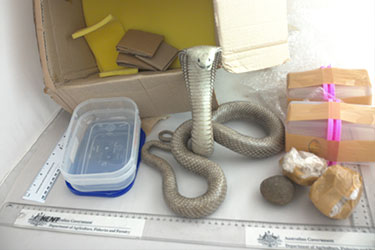
Spooky snake found in the mail.
Biosecurity officers at Sydney Gateway Facility were not charmed when they came across a dead king cobra earlier this year.
The animal was uncovered after biosecurity officers opened the incorrectly declared parcel from Indonesia.
The snake was not adequately taxidermied, stuffed or mounted and did not have documentation to support professional taxidermy process.
Biosecurity officers were also unable to determine whether the venom had been removed since the cobra’s head was intact.
If an item does not meet Australian import conditions it must be treated, exported or destroyed at the importer’s expense.
In this case, the receiver agreed to pay to have the goods treated. The snake was treated with gamma radiation and returned to them.
When you send mail to Australia, make sure you accurately declare the contents of your package on the postal declaration label.
Find out more about bringing or mailing goods to Australia.
We want your input

The department is currently seeking feedback on:
- a draft report for a review of biosecurity import requirements for fresh breadfruit from Fiji, Samoa and Tonga
- a draft report for a review of biosecurity import requirements for fresh decrowned pineapples from Taiwan
- a group pest risk analysis for mealybugs and the viruses they transmit
- a draft risk analysis for the proposed release of the fungus Kordyana brasiliensis into Australia
- the content of a new National Biosecurity Statement
- proposed changes to import conditions for bee products into Norfolk Island
See the latest Import industry advice notices or Export industry and market access notices.
